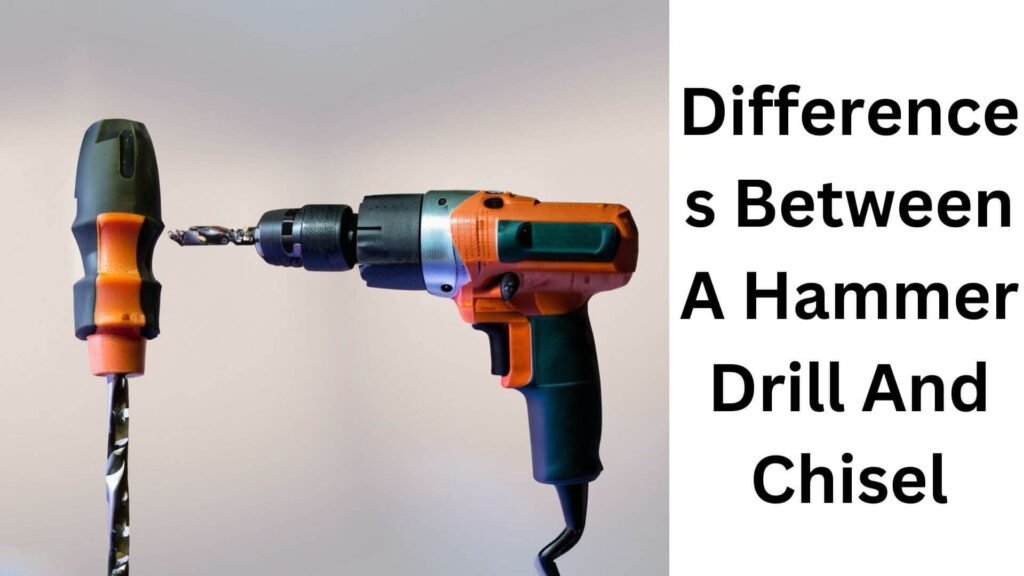Hammer drills are versatile tools widely used for tasks that require both drilling and hammering. However, many DIY enthusiasts and professionals wonder if a hammer drill can be used as a substitute for a chisel. While these tools share some similarities, they serve different purposes and are designed for distinct tasks.
In this blog post, we’ll explore whether a hammer drill can be used as a chisel, the key differences between the two tools, and how you can utilize a hammer drill in various capacities. Let’s dive into the details and answer the question: Can a hammer drill be used as a chisel?
Check Also: Here is Some Awesome Hammer Drills Under Your Budget.
Table of Contents
Differences Between A Hammer Drill And Chisel

Before we get into whether a hammer drill can act as a chisel, it’s essential to understand the fundamental differences between the two tools and what makes each one unique.
Differences Between A Hammer Drill And Chisel
A hammer drill is a power tool primarily used for drilling into hard materials like concrete, brick, and stone. It has a hammering mechanism that delivers rapid, short bursts of force to assist with drilling through tough surfaces. This hammering action is combined with the rotating drill bit to make the tool more effective on masonry.
A chisel, on the other hand, is a hand tool with a sharp edge used to chip, carve, or cut into hard materials like wood, stone, or metal. Unlike a hammer drill, a chisel requires manual force, usually applied with a mallet or hammer, to remove material.
While both tools involve breaking or cutting through hard materials, the key distinction is in the mechanism of force application: hammer drills rely on mechanical energy, while chisels require manual energy.
What Each Tool Is Designed For
Hammer Drill: Designed for drilling holes in masonry and other hard materials, often with an added hammering action to help break through the surface.
Chisel: Intended for precise cutting, carving, and shaping of materials such as wood, metal, or stone. It’s typically used in detailed, smaller-scale work like sculpting or creating grooves.
The key takeaway here is that while both tools are used for material removal, their purposes differ significantly. The hammer drill excels in larger-scale demolition or drilling, while the chisel is better suited for more delicate, detail-oriented work.
Pros And Cons Of Using A Hammer Drill Vs. Chisel For Specific Tasks
Pros of a Hammer Drill:
- Speed: Can break through hard surfaces faster than a chisel.
- Efficiency: Requires less manual labor, as the machine does most of the work.
- Versatility: Can switch between drilling and hammering modes, making it adaptable to various tasks.
Cons of a Hammer Drill:
- Lack of Precision: Not suitable for fine, detailed work.
- Potential for Overkill: For delicate tasks, a hammer drill may be too powerful and cause unintended damage.
Pros of a Chisel:
- Precision: Allows for detailed and controlled work.
- Manual Operation: Provides a tactile sense of control, making it better for tasks requiring finesse.
Cons of a Chisel:
Time-Consuming: Slower than a hammer drill for tasks involving material removal over large surfaces.
Labor-Intensive: Requires significant physical effort, especially for large-scale tasks.
Are Hammer Drills Used As A Chisel?
A hammer drill’s versatility allows it to perform various functions beyond just drilling or chiseling. Let’s take a look at some other tools and applications that hammer drills can emulate.
1. Can A Hammer Drill Be Used As A Jackhammer?
A hammer drill in chisel mode can act as a miniature version of a jackhammer. While it doesn’t have the same power or impact force as a full-sized jackhammer, a hammer drill can be used to break apart smaller surfaces like concrete, tiles, or bricks. It’s particularly useful for demolition in tight spaces or lighter jobs where a jackhammer would be overkill.
2. Can A Hammer Drill Be Used As A Normal Drill?
Yes, a hammer drill can easily be switched to function like a normal drill by turning off the hammer action. In this mode, it behaves just like any standard drill, capable of making holes in wood, metal, or softer materials. This dual functionality makes hammer drills a versatile tool for homeowners and professionals alike.
3. Can A Hammer Drill Be Used As A Screwdriver?
While it’s possible to use a hammer drill as a screwdriver, it’s not always recommended. Hammer drills are typically more powerful than standard electric screwdrivers, which can make them difficult to control for delicate tasks like inserting screws into wood or drywall. For tasks requiring more finesse, it’s better to use a dedicated cordless screwdriver with variable speed control.
4. Can A Hammer Drill Be Used As An Impact Wrench?
Though hammer drills and impact wrenches have similar hammering mechanisms, they are designed for different tasks. An impact wrench is made specifically for loosening and tightening bolts, while a hammer drill is optimized for drilling into hard surfaces. While you could potentially use a hammer drill for certain bolt-related tasks, it lacks the torque and efficiency of a true impact wrench.
Read More: Can a Hammer Drill Break Concrete?
Alternatives To Chisel For Certain Tasks
Sometimes, using a hammer drill or chisel isn’t the most efficient option for certain projects. Here are some alternatives to chisels that might be better suited for specific tasks.
1. Other Tools That Can Be Used For Chiseling
- Rotary Hammer: A rotary hammer is similar to a hammer drill but with more power and durability. It’s ideal for chiseling larger surfaces and for more demanding tasks like breaking up concrete.
- Oscillating Multi-Tool: This tool is excellent for precision work like removing grout or detailed carving, making it a better alternative to a chisel for fine tasks.
- Angle Grinder: When it comes to cutting or grinding away large chunks of material, an angle grinder with a diamond blade can be a faster and more efficient option than a chisel.
2. When To Use A Different Tool
For Cutting Material: Instead of using a hammer drill or chisel, an angle grinder or saw might be a more suitable option for cutting hard materials.
For Large-Scale Demolition: A rotary hammer or jackhammer will be more effective than either a hammer drill or a chisel.
For Fine Detail Work: A manual chisel or an oscillating tool provides the precision needed for detailed carving or shaping.
Tips For Safely And Effectively Using A Hammer Drill As A Chisel
If you do decide to use your hammer drill in chisel mode, here are some important tips to keep in mind:
Keep the Drill Cool: Overheating is a common issue when using a hammer drill in chisel mode. Make sure to take breaks to allow the tool to cool down.
Choose the Right Bit: Make sure you’re using a chisel bit that’s designed for your hammer drill. Using the wrong bit can damage both the tool and the material.
Keep a Firm Grip: Hammer drills produce significant vibrations, so ensure you have a firm hold on the tool to maintain control and prevent injury.
Use the Right Speed: Many hammer drills have variable speed settings. Use a lower speed to prevent excessive force on delicate materials.
Frequently Asked Questions On Can A Hammer Drill Be Used As A Chisel
1. Can I use a hammer drill to break concrete?
Yes, a hammer drill with a chisel bit can be used to break concrete, though a rotary hammer or jackhammer would be more effective for large jobs.
2. Can a hammer drill replace a chisel completely?
While a hammer drill can be used for certain tasks similar to a chisel, it cannot fully replace a chisel for precision work like detailed carving or shaping.
3. Can you use a hammer drill on wood?
Yes, you can use a hammer drill on wood, but it’s not ideal. Hammer drills are designed for masonry, and using them on wood can damage the material. It’s better to use a regular drill for woodwork.
4. Can a hammer drill be used to remove tiles?
Yes, you can use a hammer drill in chisel mode with a flat chisel bit to remove tiles, though a rotary hammer might be more efficient for this task.
Final Verdict
A hammer drill can certainly be used as a chisel, particularly when it has a chisel mode. This makes it a versatile tool for tasks like breaking up concrete or removing tiles. However, it’s important to remember that while a hammer drill can perform some chiseling tasks, it lacks the precision and finesse of a traditional chisel for detailed work. In certain situations, alternative tools like a rotary hammer, oscillating tool, or angle grinder may be better suited for the job.
Ultimately, whether you should use a hammer drill as a chisel depends on the specific task at hand. For large-scale demolition, a hammer drill can be an excellent choice. For more delicate tasks, you’ll likely need a chisel or another precision tool.

Hey, I am MD Hrithik Hossain, I’m a huge fan of DIY crafts. My workshop is where I spend most of my spare time, and I’m always working on some project. To that end, I’d like to share some of my knowledge and experience with you in power tools, woodworking, and other specialized materials fabrication.
I will guide you with genuine knowledge that can assist you with deciding whether a drill is appropriate according to your requirements or not. If you want to find the best drill and know which type of drill is most suited for your needs, then I can guide you with my expertise. My passion lies in helping others find the correct products they need at an affordable price.


